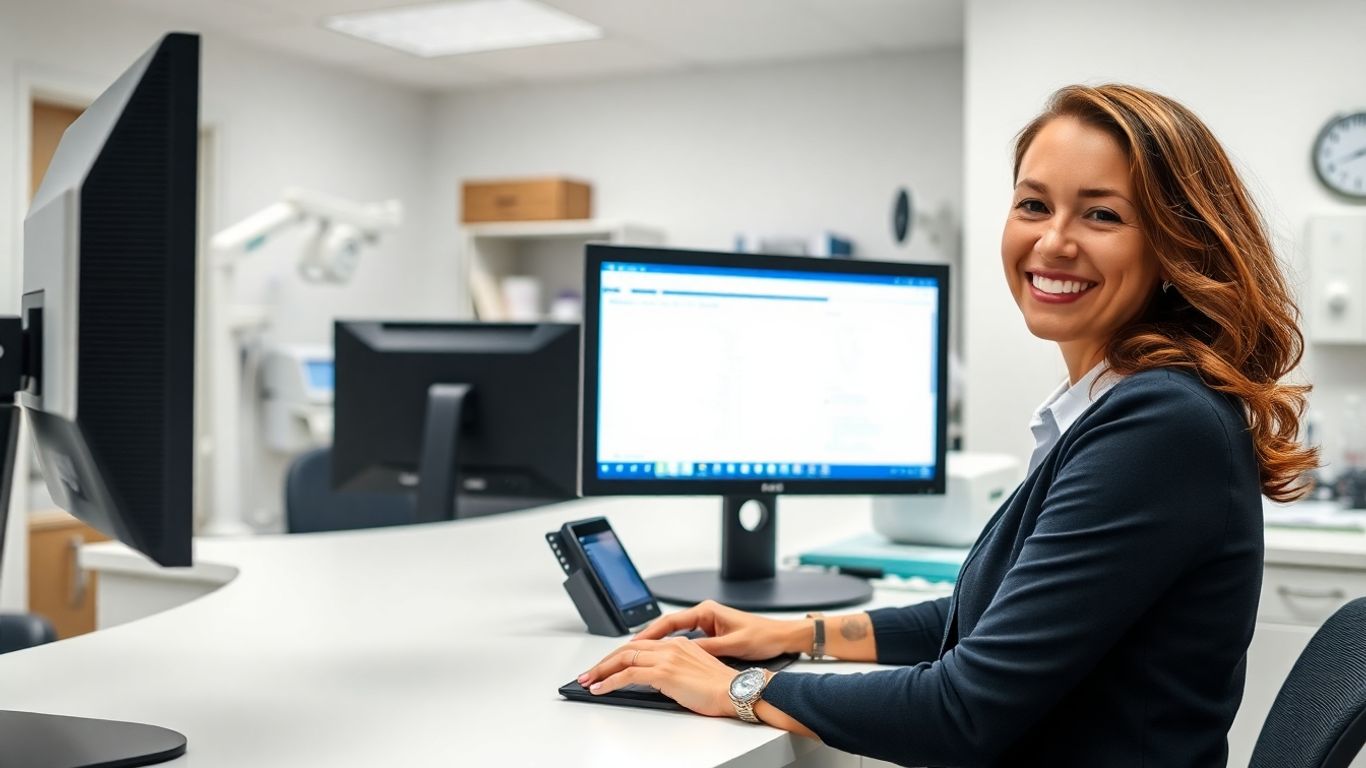Thinking about getting some help for your medical practice's front desk? You're not alone. Many offices are looking for ways to handle calls, appointments, and patient questions without adding more people in the office. A virtual medical receptionist might be just the ticket. It’s like having an extra pair of hands, but they work remotely. This guide will walk you through what you need to know to find the right fit for your practice.
Think of a virtual medical receptionist as your practice's digital front door, but way more capable than just opening and closing. It's not just a person working from home; it's often a sophisticated system, sometimes powered by AI, that handles a lot of the tasks a traditional receptionist would do. This technology is designed to make your practice run smoother and keep patients happier. It manages appointments, answers common questions, and can even help with things like insurance verification. It’s about bringing efficiency to the front desk without needing someone physically there all the time.
A virtual medical receptionist can take on a surprising number of duties. They're not just answering phones; they're actively managing patient flow and administrative tasks. Here’s a breakdown of what they typically handle:
This role is about more than just administrative support; it's about creating a positive first impression and ensuring patients feel supported from the moment they reach out.
Bringing a virtual medical receptionist into your practice can really change how things operate. For starters, it means your in-house staff, like nurses or medical assistants, don't have to get pulled away from patient care to answer the phone or manage the schedule. This frees them up to do what they do best – focus on patients. It also means you can offer extended hours or even 24/7 support for basic inquiries and scheduling, which patients really appreciate. Imagine reducing those frustrating hold times and making sure every call gets a helpful response, even after your office has closed for the day. This kind of consistent, professional support can make a big difference in patient satisfaction and loyalty.
Before you even start looking at virtual receptionist services, you really need to figure out what your practice is missing. It’s like planning a trip – you wouldn't just pack randomly, right? You’d think about where you’re going, what you’ll be doing, and what you absolutely need to bring. Same idea here. Taking the time to map out your needs upfront saves you from unwelcome surprises and helps you find a receptionist whose strengths match your patient flow and office habits.
Think about all the little things that keep your front desk busy. What tasks pop up every single day? What comes up a few times a week? And what are those monthly administrative jobs that sometimes get pushed back?
It’s important to list out everything you can think of, even the small stuff. This list becomes your blueprint for what the virtual receptionist needs to be able to do.
Now, consider how much help you actually need. Are you swamped all day, every day? Or are there specific times when your front desk is just drowning?
Think about your patient volume and when your practice experiences its busiest periods. This will give you a clearer picture of whether you need constant support or just help during specific windows.
Your patient load is a big factor. A small clinic with a steady stream of patients has different needs than a large practice that sees hundreds of people a day, especially during certain times of the year.
By really digging into these questions, you’ll have a much better idea of what kind of virtual medical receptionist will fit your practice like a glove.

When you're looking for a virtual medical receptionist, it's not just about finding someone who sounds nice on the phone. You need someone who can actually handle the tech and has the right skills to keep your practice running smoothly. It’s like hiring a mechanic – you don’t just want someone who says they can fix a car, you want someone who knows their way around an engine and can actually get the job done.
This is a big one. Your virtual receptionist will be interacting with your practice's software daily. They need to be comfortable, not just with basic computer use, but with the specific tools you rely on. Think about your Electronic Health Records (EHR) system, your scheduling software, and any patient communication platforms. Asking candidates about their experience with specific medical software is non-negotiable. It’s not enough for them to say they're "tech-savvy"; you need to know if they've actually used systems like yours before. A quick way to gauge this is to ask them to describe their experience with common EHR functionalities, like updating patient demographics or accessing appointment history. You can also ask about their comfort level with cloud-based systems, as many modern medical practices use these.
Beyond the technical stuff, how they talk to people matters a lot. A virtual receptionist is often the first point of contact for patients, so they need to be clear, empathetic, and professional. This means active listening, speaking clearly, and knowing how to de-escalate a situation if a patient is upset. It’s also about how they communicate with your in-house staff. Are they good at relaying messages accurately? Do they ask clarifying questions when needed? You want someone who can bridge the gap between your patients and your practice effectively.
Here’s a quick checklist for communication skills:
Talking about skills is one thing, but seeing them in action is another. Mock scenarios are a fantastic way to test how a candidate would actually perform under pressure. You can set up a few realistic situations they might encounter.
For example:
These role-playing exercises give you a direct look at their problem-solving abilities and how they apply their communication and technical skills in a simulated environment. It’s much more telling than just asking hypothetical questions. You can even integrate AI-powered solutions into these tests to see how they interact with automated systems, which is becoming more common in healthcare settings.
When evaluating candidates, look for someone who not only possesses the necessary technical skills but also demonstrates strong interpersonal abilities and can think on their feet during challenging situations. This combination is what truly makes a virtual medical receptionist an asset to your practice.
When you're bringing on a virtual medical receptionist, especially one who will handle patient information, security and HIPAA compliance are super important. It’s not just about following rules; it’s about making sure your patients feel safe sharing their private health details with your practice. You need to know that their information is protected.
First off, how does the virtual receptionist service handle communication? Are they using encrypted channels for everything? This means calls, messages, and any data shared should be scrambled so only the intended recipient can read it. Think of it like sending a letter in a locked box instead of a postcard. You should also ask about their network security. Do they have firewalls? How do they protect against unauthorized access? It’s a good idea to ask if they can provide documentation on their security measures. This shows they take this stuff seriously.
HIPAA is the big one in healthcare. It sets the rules for how patient health information (PHI) can be used and shared. When you hire a virtual receptionist, they become an extension of your practice, and therefore, they must follow HIPAA. This means they need to know how to handle PHI properly. A key part of this is signing a Business Associate Agreement (BAA). This is a contract that spells out how the vendor will protect your patient data. Without a BAA, you could be in hot water if something goes wrong. Also, make sure they only collect and store the minimum amount of patient data needed to do their job. No more, no less.
Security isn't a one-and-done thing. It needs constant attention. Ask potential virtual receptionist providers about their audit practices. Do they regularly check their systems for weaknesses? How often do they update their software to patch any security holes? It’s also good to know if they have a plan in place for what happens if there is a data breach. How quickly would they notify you? What steps would they take to fix it? Knowing they have a solid plan gives you peace of mind.
Here’s a quick checklist of questions to ask:
Protecting patient data isn't just a legal requirement; it's a cornerstone of patient trust. When patients trust you with their health information, they are more likely to be open and honest, leading to better care. A virtual receptionist service that prioritizes security and HIPAA compliance demonstrates a commitment to this trust, reflecting positively on your entire practice.
Making sure your new virtual medical receptionist plays nice with the tools you already use is a big deal. It’s not just about plugging things in; it’s about making sure information flows smoothly between systems so nothing gets lost or duplicated. Think of it like connecting different parts of your practice so they all work together without a hitch.
This is probably the most important connection. Your virtual receptionist needs to be able to access and update patient records in your EHR system. This means they can pull up a patient's history before a call, add notes after the call, and even schedule follow-up appointments directly into the patient's chart. It cuts down on manual data entry for your in-house staff and makes sure patient information is always current. When this works well, it’s like having an extra pair of hands that knows exactly where to find and put information.
Here’s what good EHR integration looks like:
The goal here is to make the virtual receptionist feel like a natural extension of your existing clinical workflow, not an add-on that creates more work.
Your virtual receptionist will be doing a lot of appointment booking, rescheduling, and confirming. For this to work, they need direct access to your practice's scheduling software. This could be a dedicated medical scheduling tool or even a shared calendar system. When integrated, the receptionist can see available slots, book new appointments, move existing ones, and send out confirmations or reminders automatically. This prevents double-bookings and makes sure patients always have the most up-to-date appointment information.
It’s not enough for data to just go one way. True integration means information can move freely between your virtual receptionist service and your other practice management tools. For example, when a patient books an appointment through the receptionist, that information should immediately appear in your main scheduling system. Conversely, if your in-house staff makes a change to an appointment in your system, the virtual receptionist’s tools should reflect that change. This constant, automatic sync is what prevents confusion and keeps everyone on the same page. It’s about creating a connected ecosystem where your virtual receptionist is a fully participating member, not just an isolated service.
Think about these connections:
So, you've found the perfect virtual medical receptionist. That's great! But the work isn't quite done yet. Getting them up to speed properly is super important, especially in healthcare where details matter a lot. A good onboarding and training plan means fewer mix-ups and a smoother experience for everyone, including your patients.
Think of onboarding as the first real introduction to your practice's world. It's not just about showing them the software; it's about culture, specific ways of doing things, and making them feel like part of the team, even from afar. A solid plan helps them hit the ground running.
Here’s a breakdown of what to include:
A well-thought-out onboarding process sets the stage for success. It shows your new team member that you're organized and invested in their ability to perform well, which in turn benefits your entire practice.
This is where you really shape how your virtual receptionist interacts with your patients. It's more than just reading a script; it's about understanding the nuances of your practice.
Onboarding doesn't end after the first week. Ongoing feedback is key to making sure your virtual receptionist continues to grow and perform at their best. It also helps you catch any issues before they become bigger problems.

So, you've hired your virtual medical receptionist. Great! But the work isn't done yet. To really get the most out of this new team member, you've got to keep an eye on how things are going and, importantly, ask for opinions. This isn't just about checking boxes; it's about making sure your practice runs smoother and your patients are happy.
Before you can evaluate anything, you need to know what "good" looks like. What exactly do you want your virtual receptionist to achieve? Think about specific, measurable things. It's not enough to say "answer calls." You need to define what that means for your practice.
Here are some areas to consider setting goals for:
It's also super important to communicate these expectations clearly. Don't assume they know what you're thinking. Put it in writing, discuss it, and make sure they understand the benchmarks.
Once you have those goals in place, you need to check in regularly. Think of it like a regular tune-up for your car – you don't wait for it to break down to see what's wrong.
These reviews don't have to be super formal, especially at first. A quick weekly chat might be enough to start. As you get more comfortable, you can move to monthly or quarterly reviews.
During these reviews, you should:
Remember, the goal of performance reviews isn't to catch someone doing something wrong. It's about continuous improvement for both the virtual receptionist and your practice. It's a two-way street where you both learn and grow.
Your virtual receptionist interacts with a lot of people, so getting feedback from them is gold. Your in-house staff see how the virtual receptionist integrates with the rest of the team, and patients experience the front-line service.
From Your Staff:
From Your Patients:
Analyzing this feedback, alongside the performance data, gives you a really complete picture. It helps you spot trends, address potential problems before they get big, and make sure your virtual receptionist is truly contributing to a positive patient experience.

So, you're thinking about bringing a virtual medical receptionist onto your team. That's a smart move, especially when you look at the numbers. It's not just about saving money, though that's a big part of it. It's about getting more bang for your buck and making sure your budget works harder for you. When you're shopping around, you'll see a few main ways these services charge. It's good to know what you're looking at so you don't get any surprises.
Here are the common ways virtual receptionists bill:
Figuring out your budget means looking beyond just the sticker price. You've got to think about what you're actually getting for your money. A cheaper service might seem appealing, but if it doesn't handle your patient calls efficiently or integrate with your existing systems, it could end up costing you more in the long run through missed appointments or frustrated patients. The real value comes from finding a service that fits your practice's unique workflow and patient volume.
When you're setting aside money for this, consider these points:
It's easy to get caught up in the monthly price tag, but the most cost-effective solution is the one that truly supports your practice's operations without breaking the bank. Think about the time your staff will save, the reduction in errors, and the improved patient experience. These benefits often outweigh the direct cost of the service itself.
Your practice isn't static, right? It grows, it has busy seasons, and sometimes things slow down. Your virtual receptionist service should be able to keep up. Look for providers that offer flexible plans. Maybe you start with a basic package and can easily upgrade to more minutes or advanced features as your patient load increases. Or perhaps you need 24/7 coverage during a specific busy month, but only standard hours the rest of the year. A good provider will have options that let you scale up or down without a huge hassle or penalty. This flexibility means you're not paying for more than you need during slower times, but you're also covered when things get hectic. It's all about finding that sweet spot that matches your practice's rhythm.
It's pretty wild how much technology is changing things, right? Especially when it comes to how we talk to patients. Artificial intelligence, or AI, is stepping in to make a big difference in how medical offices handle calls and messages. Think of it like having a super-fast, super-smart assistant who's always on duty.
One of the coolest things AI brings to the table is speed. We're not talking about just a little bit faster; we're talking about responses happening in milliseconds. This means the AI can keep up with conversations almost as quickly as a person can. No more awkward pauses or that frustrating feeling when you're talking to a system that just can't keep up. It makes the whole interaction feel much more natural, like you're actually talking to someone who's paying attention and knows what they're doing. It really changes the game from feeling like you're talking to a robot to feeling like you're having a real conversation.
AI can also take over when it comes to voicemails and messages. Instead of just recording a message, the AI can actually understand what's being said. It can figure out the main points of the message, who it's for, and what needs to happen next. This means less chance of messages getting lost or misunderstood. The AI can even categorize messages, sort them, and send them to the right person or department automatically. It's like having a really organized assistant who never misses a detail.
This is another neat trick. Imagine a patient calls with a question about appointment times. The AI handles the call, understands the request, and then can automatically send a text message with the relevant appointment details or a link to the scheduling page. This kind of automation saves a ton of time for both the patient and the practice. It means patients get the information they need right away, without anyone in the office having to manually type out a response. It's all about making things quicker and more convenient for everyone involved.

Let's be honest, the daily grind of running a medical practice can feel like a constant juggling act. You've got patient calls, appointment scheduling, insurance details, follow-ups – the list goes on. A virtual medical receptionist can really take a load off by handling a lot of those repetitive, time-consuming tasks. Think of it as getting a super-efficient assistant who never needs a coffee break.
Many of the front desk jobs in a clinic are pretty standard. A virtual receptionist can jump right in and manage things like:
By letting a virtual assistant handle these, your in-house team can stop feeling swamped. They can then focus on the things that really need a human touch, like directly helping patients or handling more complex issues.
When your front desk staff aren't bogged down with endless phone calls and data entry, they have more time. This means they can spend more quality time with patients who are in the office. They can help with check-ins, answer questions face-to-face, or just be more present. It's not just about getting more done; it's about improving the patient experience by having your staff available and less stressed.
When repetitive tasks are handed off, your team can shift their focus from administrative chaos to direct patient support. This not only reduces daily stress but also allows for more meaningful interactions, making everyone's day better.
What happens when a patient calls after hours or during a busy lunch rush? With a virtual receptionist, you can offer 24/7 coverage. This means no more missed calls or frustrated patients leaving voicemails that might get missed. Systems can be set up to route calls intelligently, take messages, or even schedule appointments automatically, no matter the time of day. This kind of constant availability can really make your practice stand out and keep things running smoothly, even when your office is technically closed.
Want to make your work smoother and faster? We can help you get more done in less time. Imagine your tasks flowing easily, with fewer interruptions. Ready to see how much more you can achieve? Visit our website to learn how we can help you work smarter.
So, bringing on a virtual medical receptionist might seem like a big step, but honestly, it's probably one of the smartest moves you can make for your practice right now. Think about it – less time spent on phone tag and scheduling headaches, and more time actually focusing on your patients. It’s not just about saving a few bucks, though that’s nice too. It’s about running a smoother, more efficient office that patients appreciate. Give it some thought, do your homework, and see if it’s the right fit for you. You might be surprised at how much easier things can become.
Think of a virtual medical receptionist as a remote helper for your doctor's office. They work from a different location but handle all the front desk stuff like answering calls, booking appointments, and helping patients with questions, just as if they were right there in the office.
A virtual receptionist can really free up your staff. They take care of many time-consuming tasks like phone calls and appointment reminders. This lets your team focus more on taking care of patients and less on office chores. Plus, it means you won't miss important calls, even after hours.
Not at all! Most virtual receptionist services are designed to be super easy to start. You'll typically just need to share some info about your practice, set up your schedule, and connect your phone system. Many can be up and running in just a few minutes.
Yes, it's totally possible. You just need to make sure you pick a service that follows all the HIPAA rules and uses strong security measures. Always ask them how they protect patient data and what steps they take to keep everything private and secure.
Many virtual receptionist services can help with this! They often have staff who can speak multiple languages, which is great for helping patients who might not be comfortable speaking English. It makes your practice more welcoming to everyone.
They can do a lot! This includes answering phone calls, scheduling and confirming appointments, sending reminders, taking messages, verifying insurance information, and even handling basic patient questions. Some can also help with things like prescription refill requests.
Absolutely. That's one of their biggest advantages! They can provide coverage 24/7, making sure patients can always get help or schedule appointments, even when your office is closed. They can also help manage a surge in calls during busy periods.
The cost can vary depending on the service and how much help you need. Some charge by the minute, others have monthly packages. Usually, it's more affordable than hiring a full-time person in your office because you don't have to pay for benefits or office space.
Start your free trial for My AI Front Desk today, it takes minutes to setup!








